A thought about what our choices actually cost
We say we want quality. We dream of the unique, the handmade, the lasting. We say we care about the environment, about people, about making better choices.
But when we stand there with the card in our hand, we hesitate.
“Do you have something similar – but cheaper?”
I get that question sometimes. And I understand – but it still irritates me.
Because let's be honest: you can't get genuine quality, craftsmanship and sustainability at mass-produced prices . You can't choose the ethical without also accepting that it costs more. Not more than it should – but more than we're used to paying.
Someone always pays the price
When something is very cheap, someone else pays – with their hands, their health or their future. It could be a textile worker in a factory without ventilation. It could be the river where the dye from the clothes runs off. It could be the earth's resources being depleted, a little more.
I don't want to be a part of that. And I know that many of you who find your way to More Malmo don't want to be either.
A different kind of luxury
For me, true luxury is something that is made with care. From natural materials. From hands that know what they are doing. It is a scarf from Mucros Weavers , woven on almost 200-year-old looms in Killarney. It is a bag in Italian leather that only gets more beautiful with age. A pair of rose jewelry, where each flower is unique.
It's not just beautiful. It's a statement. A yes to a slower, kinder, and more conscious way of living.
Choosing quality is choosing the future
I know it's not always easy. But think of it this way: every time you choose to forgo the cheap mass-produced, and instead invest in something that is made with care – you are making a difference. You are voting with your wallet for a better world.
So no, I don't have anything "similar but cheaper".
I have better. Really.
/Asa

